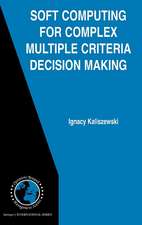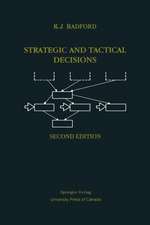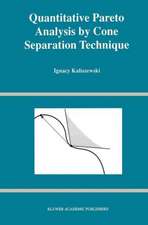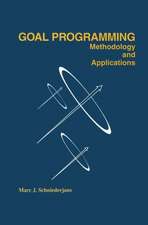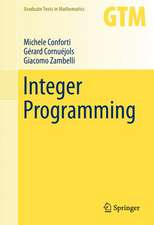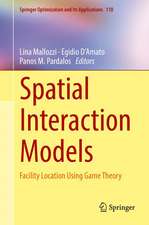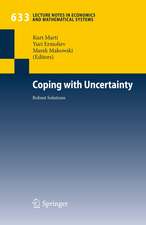Multiple Criteria Decision Making by Multiobjective Optimization: A Toolbox: International Series in Operations Research & Management Science, cartea 242
Autor Ignacy Kaliszewski, Janusz Miroforidis, Dmitry Podkopaeven Limba Engleză Hardback – 11 aug 2016
Optimizationmodels are too often oversimplifications of decision problems met in practice.For instance, modeling company performance by an optimization model in whichthe criterion function is short-term profit to be maximized, does not fullyreflect the essence of business management. The company’s managing staff isaccountable not only for operational decisions, but also for actions whichshall result in the company ability to generate a decent profit in the future.This calls for management decisions and actions which ensure short-termprofitability, but also maintaining long-term relations with clients,introducing innovative products, financing long-term investments, etc. Each ofthose additional, though indispensable actions and their effects can be modeledseparately, case by case, by an optimization model with a criterion functionadequately selected. However, in each case the same set of constraintsrepresents the range of company admissible actions. The aim and the scope ofthis textbook is to present methodologies and methods enabling modeling of suchactions jointly.
| Toate formatele și edițiile | Preț | Express |
|---|---|---|
| Paperback (1) | 478.92 lei 6-8 săpt. | |
| Springer International Publishing – 11 iun 2018 | 478.92 lei 6-8 săpt. | |
| Hardback (1) | 485.99 lei 6-8 săpt. | |
| Springer International Publishing – 11 aug 2016 | 485.99 lei 6-8 săpt. |
Din seria International Series in Operations Research & Management Science
- 20%
 Preț: 331.25 lei
Preț: 331.25 lei - 9%
 Preț: 696.06 lei
Preț: 696.06 lei - 20%
 Preț: 570.62 lei
Preț: 570.62 lei - 18%
 Preț: 1132.02 lei
Preț: 1132.02 lei - 18%
 Preț: 773.72 lei
Preț: 773.72 lei -
 Preț: 170.40 lei
Preț: 170.40 lei - 17%
 Preț: 459.35 lei
Preț: 459.35 lei - 17%
 Preț: 360.48 lei
Preț: 360.48 lei -
 Preț: 263.40 lei
Preț: 263.40 lei - 24%
 Preț: 905.31 lei
Preț: 905.31 lei - 17%
 Preț: 460.09 lei
Preț: 460.09 lei - 17%
 Preț: 459.35 lei
Preț: 459.35 lei - 20%
 Preț: 631.58 lei
Preț: 631.58 lei - 13%
 Preț: 480.01 lei
Preț: 480.01 lei - 18%
 Preț: 738.28 lei
Preț: 738.28 lei - 18%
 Preț: 1225.94 lei
Preț: 1225.94 lei - 18%
 Preț: 948.92 lei
Preț: 948.92 lei - 18%
 Preț: 703.88 lei
Preț: 703.88 lei - 18%
 Preț: 957.44 lei
Preț: 957.44 lei - 15%
 Preț: 651.84 lei
Preț: 651.84 lei - 20%
 Preț: 336.21 lei
Preț: 336.21 lei - 15%
 Preț: 641.03 lei
Preț: 641.03 lei -
 Preț: 404.29 lei
Preț: 404.29 lei - 18%
 Preț: 950.21 lei
Preț: 950.21 lei - 15%
 Preț: 649.06 lei
Preț: 649.06 lei - 18%
 Preț: 725.75 lei
Preț: 725.75 lei -
 Preț: 394.12 lei
Preț: 394.12 lei - 18%
 Preț: 951.47 lei
Preț: 951.47 lei - 15%
 Preț: 639.59 lei
Preț: 639.59 lei - 18%
 Preț: 773.06 lei
Preț: 773.06 lei - 18%
 Preț: 889.29 lei
Preț: 889.29 lei - 15%
 Preț: 655.60 lei
Preț: 655.60 lei - 15%
 Preț: 640.06 lei
Preț: 640.06 lei
Preț: 485.99 lei
Nou
Puncte Express: 729
Preț estimativ în valută:
93.02€ • 101.08$ • 78.19£
93.02€ • 101.08$ • 78.19£
Carte tipărită la comandă
Livrare economică 21 aprilie-05 mai
Preluare comenzi: 021 569.72.76
Specificații
ISBN-13: 9783319327556
ISBN-10: 3319327550
Pagini: 106
Ilustrații: XXII, 118 p. 25 illus.
Dimensiuni: 155 x 235 x 15 mm
Greutate: 0.38 kg
Ediția:1st ed. 2016
Editura: Springer International Publishing
Colecția Springer
Seria International Series in Operations Research & Management Science
Locul publicării:Cham, Switzerland
ISBN-10: 3319327550
Pagini: 106
Ilustrații: XXII, 118 p. 25 illus.
Dimensiuni: 155 x 235 x 15 mm
Greutate: 0.38 kg
Ediția:1st ed. 2016
Editura: Springer International Publishing
Colecția Springer
Seria International Series in Operations Research & Management Science
Locul publicării:Cham, Switzerland
Cuprins
Introduction.- Solving Decision Problems.- Decision Problem: Selection of a Single Variant.- Derivation of Efficient Variants.- Decision Problem: Selection of a Variant Portfolio - The Discrete Case.- Decision Problem: Selection of a Variant Portfolio - The Continuous Case.- Derivation of Efficient Portfolios.- Supporting the Process of the Most Preferred Variant Choice.- Decision Problems - Continuation.- Decision Problem: Selection of a Stock Portfolio.- Relations.
Notă biografică
Ignacy Kaliszewski, Full Professor at the Systems Research Institute of the Polish Academy of Sciences, graduated from the Technical University of Warsaw. He got his Ph.D. and habilitation degrees from the Systems Research Institute of the Polish Academy of Science for his research in quantitative management science and operations research. He has published over 40 scientific papers in journals and books of international circulation and two monographs: Quantitative Pareto Analysis by Cone Separation Technique (Kluwer Academic Publ., Dordrecht, 1994), Soft Computing for Complex Multiple Criteria Decision Making (Springer, 2006). His current field of research is decision making in multicriteria environment.Janusz Miroforidis is an Assistant Professor at the Systems Research Institute of thePolish Academy of Sciences. He received his M.S. degree in computer sciencefrom the University of Wrocław, and his Ph.D. from the Systems ResearchInstitute of the Polish Academy of Science for his research in soft computingand MCDM methods for management needs. His major research interests include computeraided multiple criteria decision making, particularly as applied to complexdecision problems and evolutionary multiobjective optimization. He is aco-founder of Treeffect, a consulting company.
Dmitry Podkopaev is a Researcher andAssociate Professor for the Systems Research Institute at the Polish Academy ofSciences. His interests include Multiple Criteria Decision Making and DiscreteOptimization. He has experience in research and software development projects(as Analyst, Developer, Programmer), as well as high school teaching.
Dmitry Podkopaev is a Researcher andAssociate Professor for the Systems Research Institute at the Polish Academy ofSciences. His interests include Multiple Criteria Decision Making and DiscreteOptimization. He has experience in research and software development projects(as Analyst, Developer, Programmer), as well as high school teaching.
Textul de pe ultima copertă
This textbook approaches optimization from a multi-aspect, multi-criteria perspective. By using a Multiple Criteria Decision Making (MCDM) approach, it avoids the limits and oversimplifications that can come with optimization models with one criterion. The book is presented in a concise form, addressing how to solve decision problems in sequences of intelligence, modelling, choice and review phases, often iterated, to identify the most preferred decision variant. The approach taken is human-centric, with the user taking the final decision is a sole and sovereign actor in the decision making process. To ensure generality, no assumption about the Decision Maker preferences or behavior is made. The presentation of these concepts is illustrated by numerous examples, figures, and problems to be solved with the help of downloadable spreadsheets. This electronic companion contains models of problems to be solved built in Excel spreadsheet files.
Optimization models are too often oversimplifications of decision problems met in practice. For instance, modeling company performance by an optimization model in which the criterion function is short-term profit to be maximized, does not fully reflect the essence of business management. The company’s managing staff is accountable not only for operational decisions, but also for actions which shall result in the company ability to generate a decent profit in the future. This calls for management decisions and actions which ensure short-term profitability, but also maintaining long-term relations with clients, introducing innovative products, financing long-term investments, etc. Each of those additional, though indispensable actions and their effects can be modeled separately, case by case, by an optimization model with a criterion function adequately selected. However, in each case the same set of constraints represents the range of company admissible actions. The aim and the scope of this textbook is to present methodologies and methods enabling modeling of such actions jointly.
Optimization models are too often oversimplifications of decision problems met in practice. For instance, modeling company performance by an optimization model in which the criterion function is short-term profit to be maximized, does not fully reflect the essence of business management. The company’s managing staff is accountable not only for operational decisions, but also for actions which shall result in the company ability to generate a decent profit in the future. This calls for management decisions and actions which ensure short-term profitability, but also maintaining long-term relations with clients, introducing innovative products, financing long-term investments, etc. Each of those additional, though indispensable actions and their effects can be modeled separately, case by case, by an optimization model with a criterion function adequately selected. However, in each case the same set of constraints represents the range of company admissible actions. The aim and the scope of this textbook is to present methodologies and methods enabling modeling of such actions jointly.
Caracteristici
Offers a concise approach to optimization from a multi aspect multicriteria perspective Explains how to solve decision problems in sequences of intelligence, modelling, choice and revive phases, in order to identify the most preferred decision variant Includes electronic materials with models presentedin the text, implemented in Excel spreadsheets Includes supplementary material: sn.pub/extras


